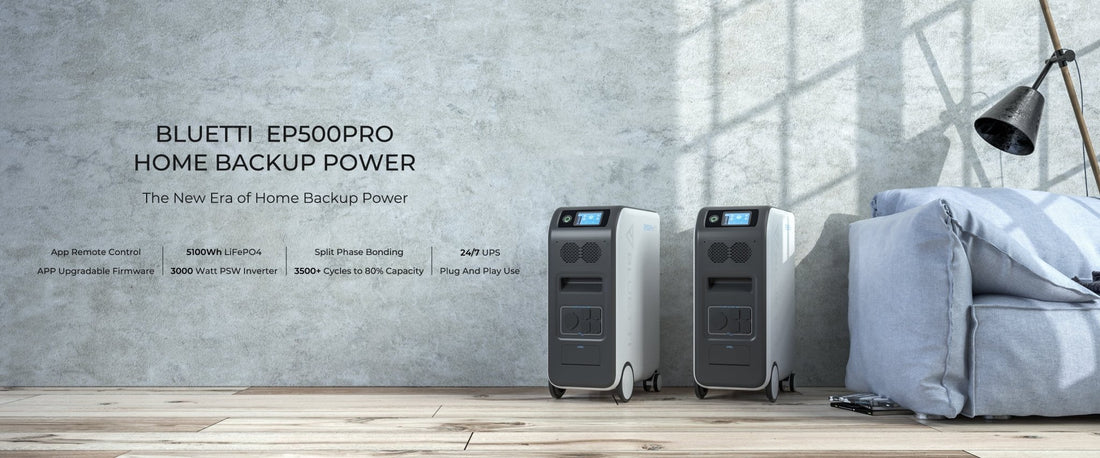
WHAT IS THE MOST POWERFUL SOLAR GENERATOR?
Eco PoweritShare
Did you know that the United States has more power outages than any other developed country?
And that as climate change becomes more prominent, such blackouts may become more common.
Having a backup source of power during these blackouts, such as that from a solar generator, may prove extremely helpful.
The question is, what is the most powerful solar generator on the market today and how can it benefit us during a power outage?
There is no doubt that the EP500 and EP500 Pro is Bluetti's most powerful solar generator, with 5100Wh, over 6000 life cycles and up to 6000 watt surge. This generator is capable of keeping all your most critical electronics running during even the worst of blackouts.
In this article we will learn why it is such a powerful solar generator and how it converts chemical energy into electrical energy.
WHAT IS A SOLAR GENERATOR?

A solar generator is a smart machine, usually coupled alongside solar panels. The device provides essential automatic backup power should there be any issues with your main electronic power grid – such as a blackout caused by a tornado.
However, there are many different types of generator and not all are as eco-friendly as the solar generator. In this article we will be focusing on the most powerful solar generator.
HOW DOES A SOLAR GENERATOR WORK?
Solar generators are usually portable, that is you can place them anywhere you want them. However, they do not include any moving parts.
The main components that make up a solar generator are:
- Inverter
- Solar panels
- Solar battery
- Battery charger
Usually, the solar panels come separate to the generator, in that they are not actually attached to the device.
Here is how they work:
Step 1. The sun’s rays contact the solar panel, and an electric field is created.
Step 2. Solar electricity is then generated and flows from the silicon cells right to the edge of the panel, and into the conductive wiring.
Step 3. The wiring then delivers that electricity into solar batteries (usually lithium ion) that are built into the generator.
Step 4. From there an inverter converts that energy from DC power to AC power before releasing it. Once the energy is released in its AC form, you can use it power various critical electronics during a power outage.
DO I NEED A SOLAR GENERATOR?

Knowing if you need a solar generator or not, all depends on your individual situation. For example does the area you live in regularly experience:
- Hurricanes
- Tornados
- Power outages
- High winds
- Extreme blizzards
Another big reason you may want to invest in a solar generator is if you have a particular interest in doomsday prepping.
If you have answered yes to any of these points, then it may indeed be worth your while to invest in a solar generator. Having one will simply give you peace of mind that you and your loved ones will have access to your most necessary technology during a blackout.
WHAT IS THE MOST POWERFUL SOLAR GENERATOR?
The defining characteristics of a powerful solar generator is the battery capacity and the AC converter (max surge capabilities).
Essentially, the higher the battery capacity and surge capabilities, the more energy demanding appliances it can power.
The below video is a demonstration of the load capabilities of the Bluetti EP500. The stronger the solar generator, the higher the load it can handle.
HOW LONG DO SOLAR POWERED GENERATORS LAST?
To understand the life span of a solar generator, its best to break it up by the components that form it.
- Inverter: On average inverters last around 10 years. This is mainly due to the fact that there are quite a few electrical components, most of which are sensitive to heat.
- Solar panels: Monocrystalline solar panels are known to have a very long-life span. Most lasting between 25 to 30 years. The reason for this is because the material is very durable and there are no moving parts.
- Solar battery: On average lithium-ion batteries tend to last 500 life cycles which is about 2 - 3 years. However, the EP500's solar battery lasts up to 6000 life cycles!
WHAT CAN YOU RUN ON A SOLAR GENERATOR?
Solar generators can run various types of electronical equipment ranging from hair dryers to power tools. The more powerful your solar generator, the larger the load it can handle.
Here is what the powerful Bluetti EP500 solar generator can power and for how long:

ARE POWERFUL SOLAR GENERATORS QUIET?
Compared to conventional gas powered generators, they are extremely quiet.
Gas powered generators produce noise between 60 and 100 decibels when listened to from about 7 meters away. That's the same noise level that a vacuum cleaner produces.
Solar powered generators on the other hand, do not have any moving parts. This means 1. the chances of something breaking is very low and 2. this drastically reduces the amount of noise they produce when running.
The only thing that tends to make a small sound is the internal cooling fan which engages whenever the appliance becomes too hot.
HOW TO CHOOSE A POWERFUL SOLAR GENERATOR?
When deciding on a the right generator there are a number of points you should take into consideration to make sure you get the best device for your needs.
We have compiled a list of 8 points for you to consider before buying your first solar generator:
- Charge speed
- Battery capacity
- Weight/portability
- Total life cycles
- Number of output points
- Inverter size
- Lithium battery
- Customer support and warranty
Let us go through each point listed above to get a better overall understanding of how to choose your solar generator.
CHARGING CAPABILITIES
This is perhaps one of the most important factors for people when deciding on solar generator to buy. After all, a power station that takes longer than a day or 2 to charge does not offer much value to you as the consumer.
Most units being sold do not charge at 500 or more watts per hour. You will likely find that the majority of solar generators charge at a speed of about 150 to 250 watts per hour.
As an example the EP500 Pro charges at 1800 watts per hour from a US wall socket (120V/15A), which means your device will be fully recharged within 3.3 to 3.8 hours.

When recharging from the sun, the EP500 Pro can be recharged by a max of 2400 watts to reach 100% capacity within 2.60 hours.

So our advice is to choose a solar powered generator that has fast charging capabilities, ideally something allowing more than 600 watts of charge per hour.
BATTERY CAPACITY
The next step is to make sure that the battery capacity within the solar generator is enough for your needs.
You should ask yourself what you will need the generator to power when there is a power outage. If you there is a large quantity of appliances on your list, chances are you will need a solar generator with a high amount of watt hours.
We recommend reading this article to learn how to correctly size your solar generator.
WEIGHT AND PORTABILITY
This is a highly individual decision. Keep in mind that a lot of solar generators are heavier than they look.
You need to take into consideration the portability factor to make sure you get a generator that you can actually move yourself.
If you can't get around the weight factor look for a solar generator that has wheels for added mobility.
TOTAL LIFE CYCLES
If you are about to invest thousands of dollars into a new solar generator, you have got to know how long it will last.
Most solar generators are made up of lithium-ion batteries. Sadly, most lithium-based generators will only last you 500 cycles. While this does sound like a lot, in reality it’s really not.
You should aim for generators that have at least 2,000 life cycles and up. If your generator has 2,000 cycles and is charged 1 full cycle per 24-hour period it would last you 5.5 years.
The Bluetti EP500 has more than 6,000 life cycles and uses lithium iron phosphate batteries.
NUMBER OF OUTPUT POINTS
This is also vastly overlooked within the industry. Many solar powered generators come with only two 120V output points.
This means you could plug in your fridge, then your freezer and now you are left with no other options. What about your entertainment, fans, and medical devices?
When choosing your solar generator you should aim for one that has at least x4 120V output points.
Having other output points such as USB and 12V car charging sockets can also be very handy!
INVERTER SIZE
Make sure the inverter will be able to handle the load you plan to run through it. For most solar generators, 1500 watts is pretty average and is usually quite sufficient in running a number of appliances.
Ideally, aim for a generator that has a built-in pure sine wave inverter. This will run everything in your house as normal as possible.
LITHIUM BATTERY
Another very important factor which most consumers overlook, is battery type. Battery type has a direct effect on the total amount of life cycles.
Many people confuse lithium-ion phosphate with lithium iron phosphate, when in fact there are significant differences in energy between the two.
Lithium-ion batteries have a higher energy density at 150/200 Wh/kg versus lithium iron phosphate batteries at 90/120 Wh/kg.
Essentially, lithium-ion batteries are the go-to source for power heavy electronics that enjoy draining batteries at a high rate.
On the other hand, lithium iron batteries can handle high temperatures with minimal degradation, this means they last much longer generally between 1000 - 10,000 life cycles.
We recommend reading this article to get a better understanding about the differences between lithium-ion and lithium iron batteries.
CUSTOMER SUPPORT AND WARRANTY
Lastly, is the need for quality customer support, pre and post-sale.
The bottom line, is you are unlikely to be able to fix a solar powered generator yourself, should it start giving issues. That is indeed where the manufacturer and warranty come into place.
With that being said, it’s imperative that whatever company makes the solar generator you are going to be using, is going to be able to help you should something go wrong.
CONCLUSION
We hope after reading this article you not only understand what make a generator the most powerful, but also know exactly how they function.
At the end of the day, the better you understand the green technology, the better your final buying decision will be.
